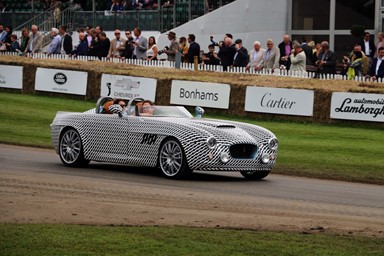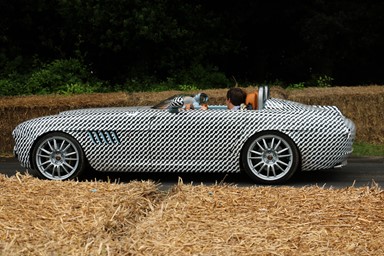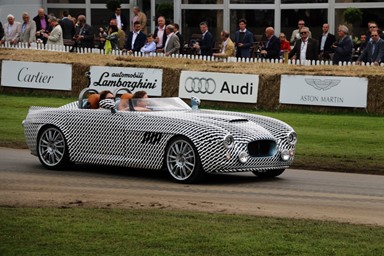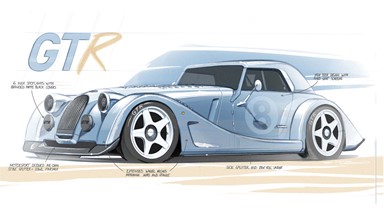Replica car production expected to start within months after NHTSA rulemaking
Replica car sales permitted under the Low Volume Motor Vehicle Manufacturers Act will start to take place within the next few months now that the National Highway Traffic Safety Administration has – after five years, numerous reminders, and one lawsuit prodding the agency – issued its final regulations on the matter.
“The roadblocks have been eliminated,” SEMA President Chris Kersting said in a press statement. “SEMA applauds NHTSA’s final rule allowing companies to market classic-themed cars.”
Since 1967, federal law has prevented carmakers from producing turnkey vehicles that do not meet federal motor vehicle safety standards. Replica carmakers have only been able to sell brand-new cars and trucks until now by selling kits or engineless vehicles that the customer then has to finish.
However, under the Low Volume Motor Vehicle Manufacturers Act, which passed in December 2015 as part of a highway funding bill, replica carmakers would be able to sell turnkey replica vehicles that do not necessarily conform to current automotive safety standards, provided they adhere to production caps (no more than 325 vehicles per year, built by companies that construct no more than 5,000 vehicles per year worldwide), use EPA- or CARB-certified current model-year engines, and replicate vehicles at least 25 years old.
The law also mandated that the EPA and the NHTSA draft guidelines and regulations for anybody who wanted to take advantage of the law within a year of the law’s passage. While the EPA issued its draft guidelines by the end of 2017, the NHTSA didn’t do so until about eight weeks after SEMA filed its lawsuit asking a federal appellate court to compel the federal agency to act.
The recent regulation, which the NHTSA issued Friday [15 Jan 2021] and which will be enacted in the Federal Register in the coming days, addresses a number of minor issues that arose when the agency issued its draft of the regulation in December 2019. Perhaps the most significant change, according to Stuart Gosswein, SEMA’s senior director of federal government affairs, is in the agency’s definition of “resemble.”
“NHTSA started off with a more conservative approach” under which replica vehicle manufacturers would be limited to the same length, width, and height as the vehicle being replicated, Gosswein said. The draft regulation even specified that the replica vehicle’s interior would have to match the original vehicle’s interior dimensions as well. “So they’d just be building reproductions. We argued that the operative word is ‘resemble,’ not ‘duplicate,” and they agreed.”
Under the revised guidelines, interior dimensions will not be considered and replica vehicle manufacturers will be allowed a 10 percent difference in external dimensions – possibly more with the agency’s permission.
“Whether a replica motor vehicle sufficiently ‘resembles’ an original motor vehicle is a matter NHTSA will decide on an individualized basis and in its discretion, taking into account the overall appearance of the vehicle,” the agency wrote in the regulation. “To be clear, the FAST Act creates an exemption program designed to allow historic models to be replicated in a less costly way by low-volume manufacturers. NHTSA does not interpret ‘resemble’ in a manner in that would allow vehicles that are merely inspired by older vehicles to be built, or otherwise allow for artistic license to create vehicles that merely remind the public of past automotive heritage.”
In addition, the NHTSA’s final regulation allows foreign carmakers to sell replica cars in the country via registered importers, relaxes the burden of proof on replica carmakers regarding copyrights and licenses necessary to produce the replica cars, and allows replica carmakers to purchase rolling chassis from production carmakers provided the two companies can agree to stamp VINs according to the specifications in the Low Volume Motor Vehicle Manufacturers Act.
The agency also clarified that its regulations apply only to vehicles that were originally offered for consumer sale and thus does not permit replica vehicles based on prototypes, concept cars, or show cars.
Roughly a dozen companies have expressed interest in replicating everything from Checkers to ’32 Fords to DeLoreans to Lamborghini Countaches to Shelby Cobras, though the unanticipated delays in the EPA’s and the NHTSA’s regulations – caused by bureaucratic delays and a plethora of unfilled positions at the NHTSA – led some of those companies to backburner or even cancel their plans.
“They’ve been waiting for this day so they can unpause,” Gosswein said.
The publication of the NHTSA’s regulations does not mean that replica car sales will start immediately, Gosswein said. “The rule will take effect immediately, but companies will still need to register with NHTSA, EPA, and CARB and get their proposals approved. It’ll be some months until sales begin, though there are definitely some companies – about five or six of them – with their proposals ready and waiting to submit.”
One potential remaining holdup concerns the number of drivetrains available for replica car companies to use in their vehicles. While it’s possible for low-volume manufacturers to use any EPA-certified production engine package, the law also specifies that the replica carmakers have to use a CARB-certified engine package, and at last count CARB only approved of one engine package: the 430-hp LS3 E-Rod V-8 crate engine from GM.
“The engine manufacturers were enthused when the law was enacted, but then everything got put on hold,” Gosswein said. “This is why our focus now will be on engine packages and on getting as many out there as possible for a variety of sizes and needs.”
While many of the replica carmakers Gosswein knows of are expected to power their vehicles with internal combustion engines, he said at least a couple are looking to go electric, possibly with packages like GM’s eCrate system.
For now, though, Gosswein said the major push is over and all that’s left for SEMA to do is help the various replica carmakers navigate the application process.
“We’re just eager to move forward,” he said.
















